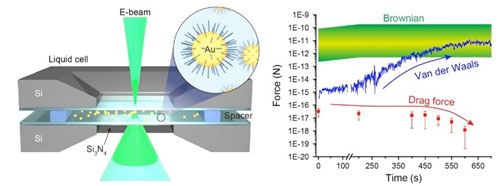| Jan 23, 2019 | |
Revealing the interplay of attraction and repulsion between nanoparticles as they assemble(Nanowerk News) A superlattice is an ordered structure formed from repeating building units, such as nanoparticles. Superlattice structures formed by the self-assembly of nanoparticles are emerging as a potentially important class of nanomaterials due to their desirable physical and chemical properties. However, a better understanding of the relationship between the dynamics of individual nanoparticles and superlattice patterns is key to controlling the structure of superlattice patterns and properties. |
|
| To address the knowledge gap, researchers from Pacific Northwest National Laboratory provide new details about the complex competition between forces at different scales in their study published in ACS Nano ("Mechanistic Understanding of the Growth Kinetics and Dynamics of Nanoparticle Superlattices by Coupling Interparticle Forces from Real-Time Measurements"). | |
 |
|
| PNNL researchers used real-time liquid cell transmission electron microscopy (TEM) observations of gold nanoparticles in toluene (left), combined with a high speed camera, to analyze and quantify the various forces (right) at work during nanoparticle self-assembly. (Image: PNNL) (click on image to enlarge) | |
Why it matters |
|
| The study builds a framework to understand particle self-assembly at a fundamental level. In particular, it provides in-depth insights of the interplay among Van der Waals, Brownian, hydrodynamic, and steric hindrance forces that control superlattice assembly, crystal growth, and particle sedimentation. | |
| Designing superlattice patterns with defined separation distances can play an important role in controlling properties such as fluorescence absorption and lifetime. Fluorescence is important for biomedicine applications such as imaging guided therapy. | |
| Researchers at PNNL are working to develop a predictive understanding of how interparticle forces drive the assembly of nanosized building blocks into tailored superlattice structures. In this experiment, the research team used liquid cell TEM equipped with a high speed camera to capture and measure the fast movements of gold nanoparticles. They examined the kinetics and dynamics of cluster growth in three stages: initial slow assembly, subsequent fast assembly, and a final post-assembly state. | |
| Initially, the gold nanoparticles aggregated via Brownian coagulation. However, strong, short-range repulsive interactions between particles led to a slow assembly process characterized by reaction-limited particle assembly. In other words, cluster growth was largely determined by particle interactions rather than diffusion. | |
| As particles became closer to each other, Van der Waals attraction force played a dominating role and increased the assembly rate. After assembly, competition between Van der Waals and steric hindrance repulsion forces led to clusters of particles that continued to move together, but did not touch. This TEM video shows the particle self-assembly process. | |
| By combining detailed analyses of the experiments with initial aggregation kinetics and population balance models, this research uncovered the critical role of particle interactions during self-assembly. The results demonstrated that cluster growth kinetics can be reasonably modeled by reaction-limited Brownian aggregation. | |
| Researchers also successfully resolved the detailed contributions and competition between the various forces and correlated these forces to the structure and dynamics of nanoparticle self-assembly. | |
What's next? |
|
| New understanding of the interactions between surface coating materials can be extended to a wide range of ligands with different chain lengths, functionalized groups, or biodegradable polymers. These advances can also be applied to the fields of material synthesis, bio-mineralization, bio-sensors, or electronic devices. |
| Source: Pacific Northwest National Laboratory | |
|
Subscribe to a free copy of one of our daily Nanowerk Newsletter Email Digests with a compilation of all of the day's news. |
